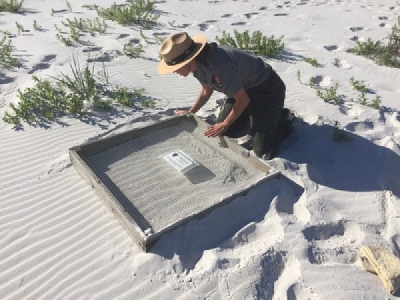
Posted on October 24, 2016
By Melissa Nelson Gabriel, Pensacola NewsJournal
Pensacola Beach and Gulf Islands National Seashore saw a record number of sea turtle nests this year despite major sand pumping and dredging projects on area beaches.
More than 6,600 tiny turtle hatchlings have made their way from 104 nests laid along a 30-mile stretch of area beaches to the warm waters of the Gulf of Mexico since May 1, according to data collected by National Park Service biologists and volunteer turtle monitors.
Nest 105 was laid just outside the entrance to Gulf Islands National Seashore on the western side of Pensacola Beach in the early morning hours of Aug. 31. As many as 100 hatchlings from that nest should emerge before the end of October marking the end of the busy nesting season.
“We are starting to reap the benefits of years of good sea turtle management,” Cassity Bromley, a biologist for the National Park Service, said on a recent afternoon as she checked the remaining nest.
Bromley laid with her ear on the sand as she listened for signs of life from dozens of sea turtle eggs buried more than a foot and a half below the surface.
“It’s amazing to see them when they start hatching and crawling out of the nest,” she said as she checked the roped-off nest to make sure it hadn’t been disturbed.
Bromley, other park service biologists and a team of volunteers worked around the clock to monitor nests and to relocate nests that were laid in the path of dredging operations.
Crews began pumping more than 1.6 million cubic yards of sand from the deep Gulf onto 8 miles of Pensacola Beach starting in early June. The project was designed to shore up eroded sections of beach and to help buffer the beach during tropical storms and hurricanes.
Turtle monitors working alongside the dredging boats moved nearly 100 loggerhead sea turtles out of the path of the work. The crews also moved several loggerhead and Kemp’s Ridley turtles, officials with the Santa Rosa Island Authority said.
Bromley and her team moved 36 turtle nests that were laid on Pensacola Beach out of the path of the work. The group spent many early morning hours carefully placing eggs in coolers and moving them to a secluded stretch of Gulf Islands National Seashore.
Gulf Breeze resident Wendy Hoeflich devoted more than 280 volunteer hours to help the park service monitor turtle nests. The work required Hoeflich to be on the beach before 5 a.m. many days. She drove up and down the beach on a small utility vehicle to check existing nests and see if there were any new nests.
“I didn’t think we would have that good of a nesting season because of the dredging and because we had such a good season last year. I thought maybe this would be a down year, but it was crazy. We had a lot of nests,” said Hoeflich, who has volunteered since 2012.
Along with her early morning hours, Hoeflich also spent some late nights alone on remote swaths of beach waiting for nests to hatch.
Watching the turtles hatch never gets old.
“If you are lucky enough to witnesses it, it is incredible,” she said. “You can put your ear to the sand and hear them moving around and then all of a sudden they come up to the surface as a group and you see them head out toward the water.”
Fellow volunteer Sean Rogan grew up on Pensacola Beach.
“I’m a water guy. I surf, I fish and I saw turtles out there all the time,” he said. His love for the turtles prompted him to volunteer with the park service two years ago.
“It’s such a rush when you find a nest or when you see the hatchlings come up from the sand,” he said.
And many of the hatchlings might not have made it to the Gulf without the help.
Bromley said crews monitor the nests to help protect the tiny turtles from predators like coyotes, ghost crabs and raccoons. The crews also help to make sure the baby turtles don’t get disoriented by artificial lights, which could cause them to crawl away from the water.
“We do everything we can to make sure they get to the Gulf. Once they make it to the Gulf, they are on their own,” she said.
Source: Pensacola NewsJournal





